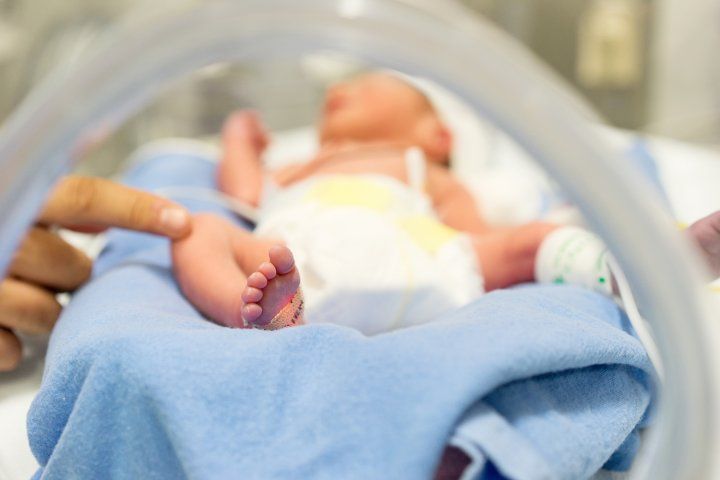People of Color Face Disproportionate Infection Risk While Pregnant

Individuals who contract COVID-19 while pregnant face a higher risk of having a very preterm birth, as well as any preterm birth, according to a large study led by researchers at UC San Francisco.
Risk of very preterm birth, which occurs at less than 32 weeks of gestation, was 60 percent higher for people infected with COVID-19 at some point in their pregnancy, while the risk of giving birth at less than 37 weeks (all preterm births) was 40 percent higher in those with infection. For those who also had hypertension, diabetes and/or obesity as well as COVID-19, the risk of preterm birth rose 160 percent.
The paper was published online July 30, 2021, in The Lancet Regional Health - Americas.
“Preterm birth is associated with many challenging outcomes for pregnant people and babies, and very preterm births carry the highest risk of infant complications,” said lead and corresponding author Deborah Karasek, PhD, assistant professor in the Department of Obstetrics, Gynecology & Reproductive Sciences, and researcher with the California Preterm Birth Initiative at UCSF.
“Our results point to the importance of preventative measures to reduce COVID-19 infection among pregnant people to prevent preterm birth, including vaccination,” she said. “Pregnant people may have concerns about vaccines and the health of their baby, so being able to have an open dialogue that values those concerns, describes evidence about safety, and conveys the risks posed by COVID-19 infection during pregnancy is critically important.”
On July 30, the American College of Obstetricians and Gynecologists (ACOG) issued updated guidance strongly recommending that all pregnant individuals get vaccinated against COVID-19. Pregnant people are considered a high-risk population for COVID-19 infection, yet less than a quarter have received at least one dose of vaccine, according to the U.S. Centers for Disease Control and Prevention (CDC).
The UCSF study was the first of its kind large enough to identify the risks of COVID-19 by specific subtype of preterm birth, as well as by race, ethnicity, and insurance status. The study data reflected both existing disparities in preterm birth rates for Black, Indigenous and other people of color (BIPOC) compared to whites, and the known outsized burden of the pandemic on communities of color. Latinx, American Indian/Alaska Native, Native Hawaiian/Pacific Islander people, as well as people with public insurance, had disproportionately higher COVID-19 rates during pregnancy. For example, while 47 percent of pregnant people in the study overall were Latinx, they represented 72 percent of the people with COVID-19 diagnoses.
“Given that the burden of COVID-19 is greater in these populations, as is the burden of pre-term birth, it really points to the need for an equity approach,” said Karasek. “With the surge in infections and increase in the Delta variant, we must think about pregnant people, especially Black and Brown populations, as the groups that need to be prioritized, with supportive policies to reduce exposure and stress, and increase access to care.”
The researchers analyzed all live births between July 2020 and January 2021 documented by California Vital Statistics birth certificates. Of the 240,157 recorded births, nearly 9,000, or 3.7 percent, indicated a COVID-19 diagnosis in pregnancy. The preterm birth rate among birthing people with a COVID-19 diagnosis was 11.8 percent compared with 8.7 percent among those without COVID-19.
The overall sample included 47.2 percent Latinx, 26.8 percent white, 4.9 percent Black, 13.2 percent Asian, 0.03 percent American Indian/Alaskan Native, 0.4 percent Hawaiian/Pacific Islander and 7.3 percent identified as other, unknown, or two or more races. Forty percent of people in the study had public insurance at the time they gave birth, and 15.9 percent had hypertension, diabetes, obesity, or a combination of these.
Having comorbidities along with COVID-19 infection increased the risk of preterm birth. Individuals with hypertension, diabetes and/or obesity as well as a COVID-19 diagnosis had a 160 percent higher risk of very preterm birth and a 100 percent higher risk of preterm birth compared to those without comorbidities or COVID-19.
Researchers found that preterm birth rates didn’t vary by whether the births were spontaneous or medically-indicated, which may indicate multiple pathways between COVID-19 diagnosis and preterm birth, Karasek said.
Limitations of the study included that it couldn't determine when during pregnancy the individuals contracted COVID-19, or how serious the infections were. These are important details for understanding the mechanisms by which COVID-19 affects preterm birth risk and Karasek said they are currently being studied at UCSF and elsewhere.
Authors: UCSF co-authors are Deborah Karasek, PhD; Rebecca Baer, MPH; Monica McLemore, PhD; April Bell, PhD; Bridgette Blebu, PhD; Kimberly Coleman-Phox, MPH; Jean Costello; Jennifer Felder, PhD; Elena Flowers, PhD; Jonathan Fuchs, MD; Kayla Karvonen, MD; Mirian Kuppermann, PhD; Safyer McKenzie-Sampson, MSPH; Charles McCulloch, PhD; Scott Oltman, MS; Matthew Pantell, MD; Xianhua Piao, MD; Aric Prather, PhD; Karen Scott, MD; Solaire Spellen, MPH; Martha Tesfalul, MD; Larry Rand, MD; and Laura Jelliffe-Pawlowski, PhD. Additional authors and affiliations can be found in the paper.
Funding: The study was funded by UCSF-Kaiser Department of Research Building Interdisciplinary Research Careers in Women’s Health Program (BIRCWH); National Institute of Child Health and Human Development (NICHD) and the Office of Research on Women’s Health (ORWH) [K12HD052163]; and the California Preterm Birth Initiative, funded by Marc and Lynn Benioff.
The University of California, San Francisco (UCSF) is exclusively focused on the health sciences and is dedicated to promoting health worldwide through advanced biomedical research, graduate-level education in the life sciences and health professions, and excellence in patient care. UCSF Health, which serves as UCSF’s primary academic medical center, includes top-ranked specialty hospitals and other clinical programs, and has affiliations throughout the Bay Area.




